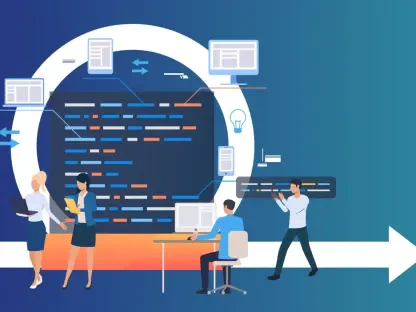I’m thrilled to sit down with Anand Naidu, our resident development expert, whose mastery of both frontend and backend technologies offers a unique perspective on the rapidly evolving world of software development. With a deep understanding of coding languages like TypeScript and Python, as well as the integration of AI in modern workflows, Anand is the perfect guide to help us unpack the trends shaping the industry. In this conversation, we dive into the surge of TypeScript as a dominant language, the pivotal role AI plays in influencing language choices, the enduring strength of Python in data science, and the future possibilities that technologies like WebAssembly might unlock.
How do you think TypeScript managed to surpass both JavaScript and Python as the most-used language on GitHub in 2025 with such a dramatic 66% surge?
I think TypeScript’s rise is a perfect storm of factors coming together. First, its static typing offers a level of reliability that developers crave, especially in large-scale projects where catching errors early can save hours of debugging. Second, the ecosystem around TypeScript has matured significantly—think of the seamless integration with frameworks like React and the robust tooling support. And honestly, the developer community has been pushing for more structure in JavaScript for years, and TypeScript fills that gap without forcing a complete departure from JavaScript’s flexibility. That 66% surge reflects not just adoption, but a genuine shift in mindset toward prioritizing safety and scalability in coding.
What role do you believe AI tools have played in accelerating TypeScript’s popularity compared to other influences like developer preference or ecosystem expansion?
AI tools have definitely been a game-changer for TypeScript’s growth. They thrive on structured data, and TypeScript’s type system gives AI models clear boundaries to work within, resulting in more accurate code suggestions and fewer errors. This makes developers more confident in using AI-generated code for TypeScript projects. While developer preference and ecosystem growth are huge—TypeScript’s compatibility with modern web development is hard to beat—I’d say AI tools amplify these advantages by making the language even more accessible and efficient to work with, especially for teams scaling up quickly.
Do you envision TypeScript holding onto this lead over Python and JavaScript in the long term, or could this be a passing trend?
I think TypeScript has a strong chance of maintaining its lead, particularly in web development, where its strengths are unmatched. However, it’s not going to displace Python in areas like machine learning or data science, where Python’s ecosystem is deeply entrenched. JavaScript, meanwhile, still has its place for quick prototyping and smaller projects. The real question is how AI and emerging tech like WebAssembly might level the playing field. If portability becomes less of an issue, TypeScript’s dominance could be challenged, but for now, I see it staying ahead for at least the next few years.
How is AI influencing developers’ decisions when it comes to picking a programming language for their projects?
AI is shifting the decision-making process in a big way. Before, developers chose languages based on personal comfort, runtime needs, or library support. Now, they’re also asking, ‘How much help will AI give me with this language?’ If a language like TypeScript or Python has been widely used in training data for AI models, those models can generate more reliable code and offer better autocomplete or debugging suggestions. This creates a practical incentive to pick languages where AI can act as a force multiplier, reducing friction and speeding up development cycles.
Why do you think statically typed languages like TypeScript are often more compatible with AI tools compared to dynamically typed languages like Python?
Statically typed languages provide a clear structure that AI tools can lean on. With TypeScript, the type system acts like a roadmap for the AI— it knows what kind of data to expect and can generate code that fits those constraints. This reduces the chances of vague or incorrect outputs. Python, being dynamically typed, offers more flexibility, which is great for developers but can confuse AI models since there’s less explicit information to guide them. That structure in TypeScript helps AI tools produce code that’s not just functional but also easier to validate.
With AI models performing better on widely used languages, do you think this creates a self-reinforcing cycle where popular languages just keep gaining ground?
Absolutely, it’s a feedback loop. The more a language like TypeScript or Python is used, the more data AI models have to train on, which makes the models better at supporting those languages. In turn, developers are drawn to languages where AI assistance is strongest because it saves them time and effort. This cycle can marginalize less popular languages, even if they’re technically sound, simply because the AI support isn’t as robust. It’s not just about the language’s merits anymore; it’s about the ecosystem of support that AI builds around it.
Can you explain how the guardrails of statically typed languages help developers trust AI-generated code?
Statically typed languages act as a safety net for AI-generated code by enforcing rules about data types upfront. If an AI tool suggests a function, the type system in a language like TypeScript can immediately flag if the input or output doesn’t match the expected type, before the code even runs. This gives developers a quick way to spot potential mistakes without needing to test every line manually. It builds trust because you’re not just relying on the AI’s output—you have a built-in mechanism to verify it, which is crucial when you’re moving fast and integrating AI suggestions on the fly.
What are some specific errors in AI-generated code that typed languages help catch more easily?
One common issue with AI-generated code is mismatched data types—like passing a string to a function that expects a number. In a typed language, this error gets caught at compile time, often with a clear error message pointing to the problem. Another example is incorrect object structures; if an AI generates an object missing a required property, a typed system will flag it before runtime. These might slip through in a dynamically typed language until you hit a bug during execution, which can be much harder to trace. Typed languages make these slip-ups visible early, saving a lot of headache.
For developers accustomed to dynamically typed languages like Python, do you think the advantages of switching to typed languages for AI support justify the learning curve?
It really depends on the developer’s goals and project needs. If you’re working on something where AI assistance is a major part of your workflow, and you’re dealing with complex systems, the benefits of a typed language—like better error detection and AI compatibility—can outweigh the initial learning curve. But for someone deep in Python’s ecosystem, especially in fields like data science, the switch might not be worth it since Python itself has strong AI support and tools like type hints can bridge some gaps. It’s about weighing the trade-offs and deciding if the safety net is critical for your work.
Python continues to dominate in machine learning and data science. What keeps it so unbeatable in these domains despite TypeScript’s rise?
Python’s dominance in machine learning and data science comes down to its incredible ecosystem. Libraries like TensorFlow, PyTorch, and pandas are not just tools—they’re industry standards with massive community support and documentation. Add to that Python’s simplicity, which lowers the barrier for researchers and non-traditional developers to jump in, and you’ve got a recipe for staying power. TypeScript’s rise is impressive, but it’s solving different problems, mostly in web and app development. Python’s niche in AI and data work is almost unassailable because it’s been built for those use cases over decades.
How does AI assistance enhance Python’s strengths in machine learning and data science compared to other languages?
AI assistance supercharges Python by automating repetitive tasks like data preprocessing or boilerplate code for models, which lets developers focus on the creative and analytical aspects of their work. Since Python already has a vast amount of training data in AI models, the suggestions and code generation are often spot-on for libraries like NumPy or scikit-learn. Compared to other languages, Python’s sheer volume of resources and AI familiarity means the assistance feels more tailored—developers get relevant snippets faster, and that efficiency keeps Python ahead in these fields.
Looking ahead, what is your forecast for the role of emerging technologies like WebAssembly in shaping the future of language choice and software development?
I’m really excited about WebAssembly’s potential to shake things up. It’s already starting to break down barriers by allowing code from almost any language to run in browsers and other environments with near-native performance. This could mean that language choice becomes less about where your code needs to run and more about what ecosystem or tooling gives you the most leverage. Combined with AI-generated code, we might see a future where developers write in their preferred language, compile to WebAssembly, and deploy anywhere. My forecast is that within the next five to ten years, WebAssembly will push us toward a world of true interoperability, where the lines between languages blur, and the focus shifts to productivity and collaboration between humans and machines.









